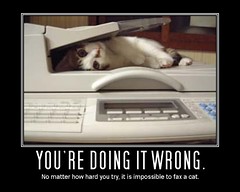Twitter is a 1978 Fax Machine – Metcalfe’s Law and The Twitter Nielsen Data
May 2nd, 2009 by
First things first: this post is a bit of inside baseball – it may be conceptually interesting but it likely won’t help you market your business.
What’s interesting to me about the recent Nielsen data regarding “Twitter Quitters” is that it makes a prediction based on current data without looking at how this technology is like others before it. Surely Nielsen
doesn’t have data on adoption of all technologies since the beginning of time, but if they thought a little harder they might find some similarities. Or perhaps they just want the attention of controversy.
states that the value of a telecommunications network is proportional to the square of the number of connected users of the system.
The most common illustration of this is the fax machine. One fax machine = paperweight, two fax machines = dialog, ubiquitous fax machines = global communications in the pre-email era.
So what’s the point?
My contention is this: Twitter (per the Nielsen data) is a 1978 fax machine. If you had one you thought you were really cool, but the reality is you were probably only impressing yourself.
If you’re not aware of the concern, here’s a little background:
- Twitter Quitters Post Roadblock to Long-Term Growth
- Retention Problem for Twitter?
- Proof That Nielsen is Wrong; Twitter’s Retention Rate is Not 40%
I mean think about it. If you’re not one who is naturally tapped into online communication you sign up, cruise around without an instruction manual or map and it’s boring. “Where to now?” you must think. Then the phone rings, the teapot whistles or the dog barks and you’re outta there.
Unless you’re already in the know it’s hard to find the great resources there are out there:
It’s no wonder there’s a 60% dropoff rate.
If you believe TechCrunch, at the end of April there were a few more than 1 million users of Twitter with only around 200,000 really active.
From TC :
March 2008
- Total Users: 1+ million
- Total Active Users: 200,000 per week
- Total Twitter Messages: 3 million/day
So let’s look at that in context. With around 1 million users worldwide 40% of whom are in the U.S. that means that only about 400,000 U.S. folks are on twitter.
So… if you’re not one of those 400,000 you’re one of the other 299,600,000, or thereabouts, U.S. folks who aren’t yet on Twitter. That means you’re not one of the 13/100ths of 1 percent who are already hip.
That’s a really small number. I mean really small. You might be lonely.
So, I come back to likening Twitter to a 1978 fax machine. Currently Twitter lacks mass utility — so did a fax machine in 1978. Where’s the fax now?
The Fax is ubiquitous
.
Photo Credits:
- Network Effect image from Wikipedia
- Fax Cat courtesy of anomalous4
- Lonely Bench courtesy of Ann Kinney





Great post Will. I was a huge skeptic of Twitter till quite recently. Micro-blogging? WTF? Common, how lame is that. Flash in the pan. Then I tried it, saw all my colleagues in SEO on there, followed along the conversations, noticed how much info and links get shared (to the abandonment of my RSS feeds) and quickly saw the value. But I’m one of the cool kids in the know, though late to the game.
But I can certainly see why many “average” users tire of it quickly. They simply use it as text messaging, sharing trivial info about their day, not sharing links or any deeper information. Exactly what I assumed it would only be till I actually got on board.
So what will it take for the average web user to delve deeper into the utility that does exist with twitter? Seeing others, that they follow, sharing links and other deeper info will get them into doing more of the same.
Twitter is still essentially in it’s infancy so we’ll see how well it can really penetrate into the mainstream and if it can stick.
Thanks Stever,
I am completely with you. It was @MackCollier who made me first sign up, but like you, it wasn’t until I realized the utility of having all this information in one place that it really took hold for me.
When I was working with Yellow Pages guys they would talk about the issue of launching a new phone book as one of “Critical Mass” (chicken and egg really), without the rich content of advertisers, no usage; without usage no advertisers.
Twitter is like that: we who are on and active have found a critical mass of other users who validate the tool’s utility. Until everyone who signs up is able to find enough users like them to validate their usage we’ll continue to see the high dropoff rates.
Will
[…] Quitters – Much has been made of the Nielsen report which pegged Twitter’s retention rate at only 40%. While even at this retention rate Twitter can […]
Twitter is also a great tool for increasing traffic to youtube videos